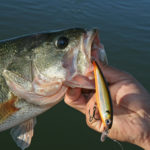
When it comes to matching lures, speed kills
A question I get at a lot of fishing shows where I do seminars has to do what kind of reel I choose for most of my crankbait fishing. A lot of fishermen want to know about the retrieve ratio of reels, and what ratio they should be using for what baits.
Since April is all about sight-fishing, and I can’t stand to sight-fish, its as good a time as any to talk about reels, because it’s a month when you could conceivably use reels from every part of the retrieve-ratio spectrum. You can be burning a spinnerbait or cranking a small crankbait, fishing a jerkbait, a jig or an Alabama rig, and all of them require a little something different from your reel.
I’ve been using Lew’s reels almost since they began making them back in 1975, and they are available in a number of different grades and several different retrieve ratios. Using their numbers as a guide, it’s not too hard to figure out what reel you should be using for different aspects of your day on the water.
What is retrieve ratio? It’s basically the amount of line that’s wound up on the spool of the reel for each turn of the handle, and it’s described in terms of two numbers in a ratio. For instance, the reels that Lew’s makes have 7-to-1, 6.4-to-1 and 5.4-to-1 ratios, and they’re coming out with a 4.7-to-1 reel. The larger the first number, the more line that’s wound on in one turn of the handle, so the “faster” the reel is.
Some retrieve ratios will work for just about anything you’ll be fishing, but then you have some reels that are more specialized. The big thing is, you can change your reels according to the retrieve ratio, and you don’t need to worry about how fast or slow you’re winding the handle. You can wind it the same speed and the reel will either take up more or less line.
You want a reel with a very fast retrieve ratio, like 7-to-1, when you’re a bait that you have to wind in quickly, like a buzzbait or a lipless crankbait when you’re burning it just under the surface. Sometimes, a fast-retrieve reel is good for fishing a jerkbait.
The 6.4-to-1 and 5.4-to-1 are more popular retrieve ratios if you’re fishing a worm or a Carolina rig. The only difference between the two is really just a couple of inches for each turn of the handle, but that does make a difference. Say you’re swimming a jig or swimming a worm; you probably want the 6.4-to-1, because a lot of time, fish will hit those baits and knock them toward you, and being able to take in a few more inches of line can wind up being very important when you’re trying to catch up to a fish.
A 6.4-to-1 reel is a good spinnerbait reel if you’re fishing it right under the surface or burning it. You can cast or pitch a worm on a 6.4-to-1 reel because it’s a little more versatile. A 5.4-to-1 reel gives you a little bit of advantage if you’re fishing a small crankbait and not reeling too fast; 5.4-to-1 is optimal for a crankbait, and it’s good when you’re fishing a lipless bait around grass.
One thing to consider is, how fast do you like to wind your reel? If you’re like me, and you like to stay “busy” the way I do, a slower retrieve reel is better.
Now, the 4.7-to-1 reel that Lew’s is coming out with — it’s supposed to come out sometime after July, but I don’t know exactly when — that’s a great retrieve ratio for an Alabama rig or a deep-diving crankbait. It’s the ultimate crankbait reel. As a general rule, anytime you want to “sink” a bait to the bottom, you want to fish a reel with a slow retrieve ratio. A 4.7-to-1 is a great reel for slow-rolling a spinnerbait or fishing something like a Fish Head Spin and a Fluke.
A couple of things change as you change retrieve ratios. The slower the retrieve, the more power you’ve got. You won’t wear your arm out fishing a deep-diving crankbait or an Alabama rig on a slower reel because of the power. Another consideration is, the lighter the reel you can fish, the better. Lew’s makes its Tournament Pro reel with 11 ball bearings at six ounces. You wouldn’t think that a difference of only two or three ounces in weight would amount to anything, but the fatigue that a light reel saves your hand is worth its weight in gold.
So when you start putting rods and reels together and putting them in your rod box, make sure you have them matched for the task at hand. Your cranking rod and the rod you fish an Alabama rig with should have as slow a reel as possible. Your buzzbait outfit needs to be fast, and everything else can be in-between.
As long as it winds up with you getting the lower jaw of a big bass between your finger and thumb, everything’s wonderful.






Be the first to comment